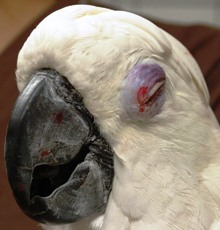Trauma in Pet Birds
 Birds can injure themselves quite easily in the typical household. It is important to "bird proof" your home so that you lessen the chance of serious accidents.
Birds can injure themselves quite easily in the typical household. It is important to "bird proof" your home so that you lessen the chance of serious accidents.
Flighted Birds
Free-flying birds are much more likely to be injured around the home. Unfortunately, one of the most common causes of injury is the ceiling fan. Free-flying birds and moving ceiling fans are a deadly mix so if you like to let your pet fly around, always make sure the ceiling fans are off! Some people actually put a lock over the switches controlling their ceilings fan so they have to think twice before turning them on! Another common cause of injury is flying into a window or mirror. Putting up cut-outs on the windows and mirrors sometimes helps birds lean to avoid them but the risk is always there. Light gauze curtains that barely reduce the light but clearly show the bird the window is not a "free flight" zone are one possible way to help a bird avoid injury. Another deadly possibility is the stove and oven. Sadly, some birds have met gruesome ends by landing in a pot of boiling water or even flying into an open oven door. If you are cooking, your free flying bird needs to be in its cage or locked away in another room.
Wing-trimmed Birds
Even birds that have had their wings trimmed run the risk of injury. If wing feathers have started to grow back and you haven't noticed, a bird may get a little bit of lift and end up in a long-distance glide that can run into the sorts of dangers described above. Sometimes birds have their wings trimmed too short so that they fall rapidly and can injure their chest when they hit hard floors.
If Your Bird Injures Itself
Any time a bird has a drooping wing or doesn't bear weight on a leg it has suffered a serious injury and needs to be seen by a veterinarian soon.
You should contact your veterinarian immediately if your bird has any of the following signs after its accident:
- Nonresponsive or poorly responsive
- A broken bone, or a cut that exposes a bone
- Bleeding that cannot be stopped (e.g., from blood feather, nail, or beak)
- An eye injury or the eye appears enlarged or protruding
- An attack by an animal
- Has been hit by a moving object
- Puncture wounds
- Any trauma to the head
- Flying into a window or other object
- A severe laceration, or an incision that has opened and the skin is gaping
- Mishandling (e.g., squeezed by child, hit by edge of net, etc.)
- A burn or scalding
You should contact your veterinarian within 8 to 12 hrs if your bird has any of the following signs following an injury:
- Sitting fluffed up, huddled, or at the bottom of the cage
- Swollen joints or feet
- Lameness or favoring a leg
- A drooped or elevated wing
- Crusting or discoloration of the feet



